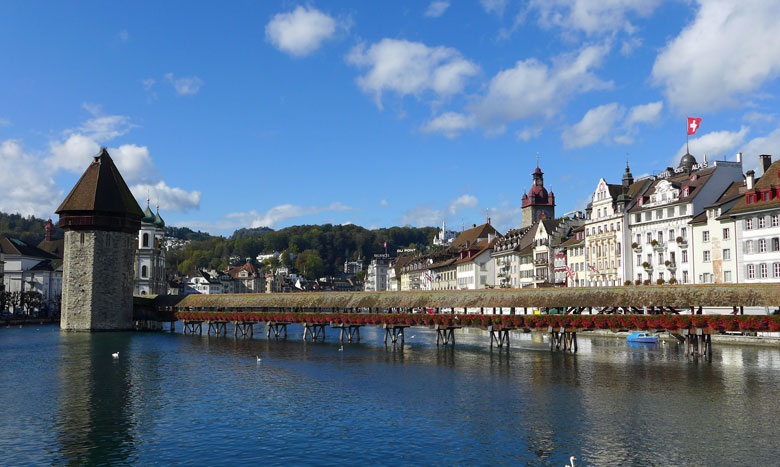Lucerne is one of Switzerland’s top tourism hubs, but it’s also an actual city so it offers great restaurants, shopping, and unusual attractions as opposed to just skiing and mountain sports. For this reason, choosing where to stay in Lucerne is more important than it is in some other areas you might visit. The article linked just above offers advice on by far the best area to stay in with some hotel suggestions including a suggestion if you are driving and are looking for free parking.
When people ask where they should go in the country my standard answer is that you should go to the Interlaken area if you only have 2 or 3 days, but if you have more than that you should definitely add Lucerne to your trip and you’ll see the things to do below make it clear why this area is so special.
Is Lucerne worth visiting? Yes, however...
The answer to this question may seem obvious, but it’s a question that gets asked a lot and the answer isn’t quite as straightforward as it may seem. Lucerne is absolutely worth visiting, although I wouldn’t actually recommend that it be your first or only stop in Switzerland. I cover this more in my article about where to go in Switzerland on a short trip and even more in my article about Lucerne and Interlaken.
The short version is that in my opinion, if you only have 2 or 3 days to spend in Switzerland I’d recommend you spend them in the Interlaken area. I get a lot of questions about Europe itineraries and it’s surprisingly common that people only leave a few days for this whole country. Part of it is because it’s a small country and it’s also very expensive, even compared to its neighbors.
So yes, definitely plan on visiting Lucerne, and the Interlaken area as well. In my opinion the top few attractions on the list of things to do in Interlaken are more impressive and more dramatic than the top few things on the list below. So as long as you have at least 4 or 5 days to visit Switzerland, I’d highly recommend spending at least 1 or 2 of them in Lucerne (Luzern in German, which is the local language), and it’s a good first stop on a trip like that.
Things to see in Lucerne in 1 day or a day trip

The things to do in Lucerne, Switzerland listed below are basically in order from most interesting to not quite as interesting or unique. So if you are only able to plan a day trip to Lucerne you should choose however many of the top few that you’ll be able to fit into your day. Some people getting an early start from Zurich might have 12 hours in Lucerne and in that time you could do perhaps 3 or 4 of the best things to do in Lucerne.
There are three mountain peak attractions in the Lucerne area (Mt Rigi, Mt Titlis, and Mt Pilatus) and each of them is fantastic, but if you’re also going up Jungfraujoch or Schilthorn in the Lauterbrunnen Valley near Interlaken, then I would put less priority on the mountains near Lucerne because they aren’t quite as spectacular. On the other hand, the historic center of Lucerne including the Chapel Bridge, is MUCH more interesting and photogenic than the town of Interlaken, so I would prioritize that and the lake cruise if you only have 1 day in Lucerne.
What to do in Lucerne for 2 days?
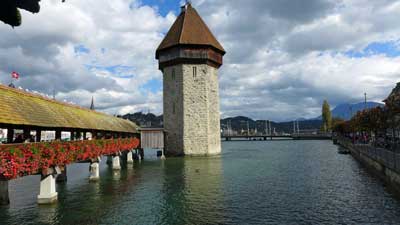
Each of the mountaintop trips takes about half a day (4 or 5 hours) and it seems redundant to do all three and I probably wouldn’t even do two of them. Again, if you’ve got the time on your trip I would recommend doing the Jungfraujoch or Schilthorn trips near Interlaken, and choose just one of the mountains near Lucerne.
You’ll want to do a walking tour at your own pace of the historic part of the city and that should be at least a few hours. During the summer months you can actually save that for the evening and do the lake cruise and a mountain journey or two during the day. There are many other fun things to do in Lucerne and you’ll probably find out about a few more of them when you are actually there. But the list below will just be the main highlights that you should plan the rest of your visit around.
Things to do in Lucerne in winter
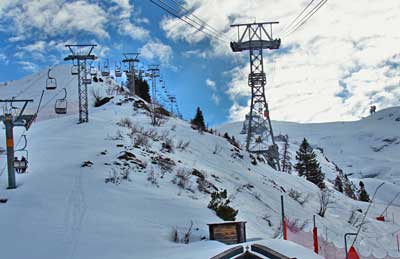
The good news is that there are ski lifts and full facilities on all three of the mountain peaks mentioned below (Mt Rigi, Mt Pilatus, and Mt Titlis). Mount Rigi is the closest of the three to Lucerne, while Mt Titlis is about 45 minutes away by train although it’s by far the tallest of the three and has more winter facilities as well.
As you’d expect, you can rent skis or a snowboard and boots and poles and everything else at any of the nearby resorts, or in town if you prefer to get fitted in advance (and lug everything with you!). There’s much too much information to summarize it will here, but suffice to say that from December through March you’ll be able to find good snow in this area and with a bit of planning and research you’ll be hitting those slopes exactly as you are dreaming about.
Things to do in the Lucerne area, in order of uniqueness and convenience
The list below of things to do in Lucerne is not a long one, partly because most people are just coming for one or two days and most of the things on the list will take all of that time and more so you have to choose the few things that sound most interesting to you.
The first couple of things on the list (self guided walking tour and Chapel Bridge) are things that almost everyone will do whether they did any research or not before showing up. You can even do those things in the evening, especially in summer, so you’ll have days free for the lake cruise and the mountaintop attractions below.
Self-guided walking tour of historic Lucerne

As discussed in detail in the article about where to stay in Lucerne, this is also the best and most convenient area to stay in and the linked article has a bunch of suggested hotels in different price ranges. Again, unlike Interlaken, which feels about 95% about tourism, Lucerne is a real historic city with a population of about 80,000, and it feels much more like a real small city rather than a theme park.
Hopefully your hotel is somewhere in this area so just the walk from the train station to your accommodation will be part of the walking tour. There is a small section of the historic district that is south of the Reuss River, but the majority of it is just north. There’s a normal bridge that takes you across the river and along that shore there are several hotels, restaurants, and shops.
In the streets and pedestrian alleys behind those buildings you’ll find a gorgeous upscale shopping district with fashion stores and quite a few useful shops as well. You can walk around this area in half an hour or so if you don’t pop into the stores to look at the merchandise, and it’ll be a half hour well spent when you first arrive.
Chapel Bridge and Lion monument
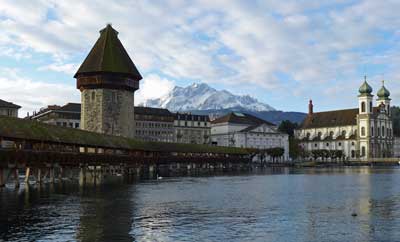
The bridge was originally built around the year 1360 and a few hundred years later they added artwork to the overhead panels showing some of the history of Switzerland and Lucerne itself. It’s definitely worth walking the length of the bridge at least once and looking up to check out some of the illustrations.
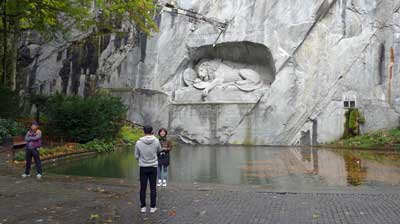
It’s a statue of a wounded lion, carved into the wall, and it’s larger than you might expect just based on photos. It was sculpted in 1820 or so and it’s interesting to think that Lucerne was over a thousand years old at that point. Honestly, it’s not a big deal if you decide to skip it, but it’s popular and you’ll be pretty close to it at some point and it’s free so you might as well walk the extra couple of blocks to take your own photo.
Lake cruise and possible Mount Rigi visit at the same time
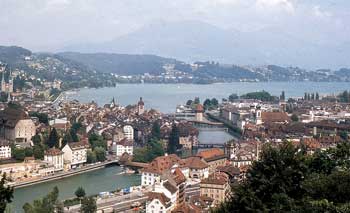
If you have more than an hour to spare you have several other options that range from 2 to 4 or more hours and those boats stop at a variety of small villages along the way. There are themed cruises that include lunch and other options that may sound more interesting than just riding around on a boat making stops at small villages.
Two of those small villages, namely Weggis and Vitznau, are key departure points because each of them provides further transportation to reach the top of Mt Rigi, which is just north of the villages. The peak is called Rigi Kulm and there are a few ways to reach it including a cogwheel train that goes all the way and a cable car that goes most of the way. Many people like to take one of them up the mountain and the other one down, and then hop back on the next boat to take you back to Lucerne.
Mount Rigi

The most common way for visitors to reach the top is to take the lake cruise mentioned above (make sure it’s one of the cruises that stops in these villages) and hop off in the village of Weggis. It’s a short walk to the cogwheel train that goes all the way up to the Rigi peak in about 30 minutes. There are four different restaurants up there including one that stays up until 20:00 (8 PM) so you can have dinner there.
There is a cable car (a large gondola on a wire) that goes from the next village called Vitznau up to a stop called Rigi Kaltbad, where you can catch the cogwheel train that goes up the last stretch to the peak. Combining the cogwheel train and the cable car takes about 40 minutes, but it’s a whole different experience so most people like to take one route up and the other route down.
The whole journey up and down Mt Rigi costs about US$75 using either method, but the good news is that the Half Fare Card cuts that price in half and it’s ALL covered for free, including the lake cruise itself, if you have the Swiss Travel Pass. The Swiss Travel Pass may seem expensive at first until you discover how expensive each included thing is on its own. Long story short, read our Swiss Travel Pass review for more information on all of it, and even if you don’t get a pass you almost certainly should get a Half Fare Card, and those are also discussed in that article.
Mount Pilatus
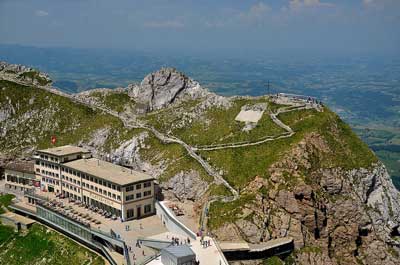
The good news is that you can get from Lucerne to the bottom of the ascent by bus or train or even by boat from May through October. Then once you get there you can choose from a gondola ride, a new cable car called the Dragon Ride, and the world’s steepest cogwheel railway. Each method takes between 30 and 60 minutes in each direction and it’s all explained on the official Pilatus website.
There are two restaurants on top so another good option for lunch if the timing works out because the prices tend to be similar to what you find in town. Prices for each way up are around CHF80 return, but again, they are all half price with the Half Fare Card or if you have the Swiss Travel Pass, and you will want at least one of those for your trip because it will save you a lot more than it costs.
Mount Titlis
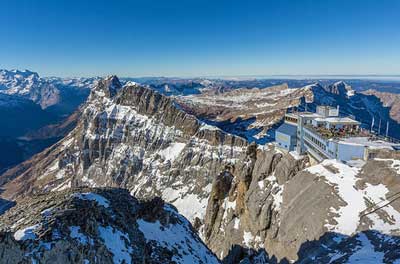
The first step for those who didn’t drive will be to take a train from Lucerne to the mountain village of Engelberg, which is about 35 kilometers (and 43 minutes) from Lucerne. If you did drive you can park for a reasonable amount in the parking lot for the gondola that you take in two sections from the valley floor station to one called Stand. From Stand you’ll take the new Rotair rotating cable car the rest of the way to the top.
The tickets from Engelberg to the peak are CHF 96, but again, are half price with the Half Fare Card or the Swiss Travel Pass. Unlike the peaks mentioned above, Mount Titlis is kind of a self-contained snow park (even in summer) at the top and everything is included in the price of getting up there.
There is Glacier Cave, which is a 150-meter ice tunnel that is open all year. There is the Titlis Cliff Walk, which is 3,238 m (10,623 ft) is Europe’s highest suspension bridge and kind of a thrill attraction even though it’s totally safe. They have what they call the Ice Flyer – a 6-chair ski lift that actually isn’t included in all tickets, but it does travel over snow all year round and you can do winter things in summer.
Lastly there is Glacier Park, which is at the other end of the chairlift and they offer sledding and snow tubing with gear that they will lend you while you are there. Of course there are a couple of restaurants and shops so you can have lunch and enjoy the views even more if you plan well.
Since Mt Titlis is almost an hour by train in each direction just to get to the base of the gondola ride, you’d spend a minimum of 6 hours from Lucerne and back to Lucerne, and many people spend more like 8 hours because there is a lot to do on top and most of it is included in your ticket. So Mt Titlis is basically a full day, and you have time to walk around Lucerne in the evening when you get back.

